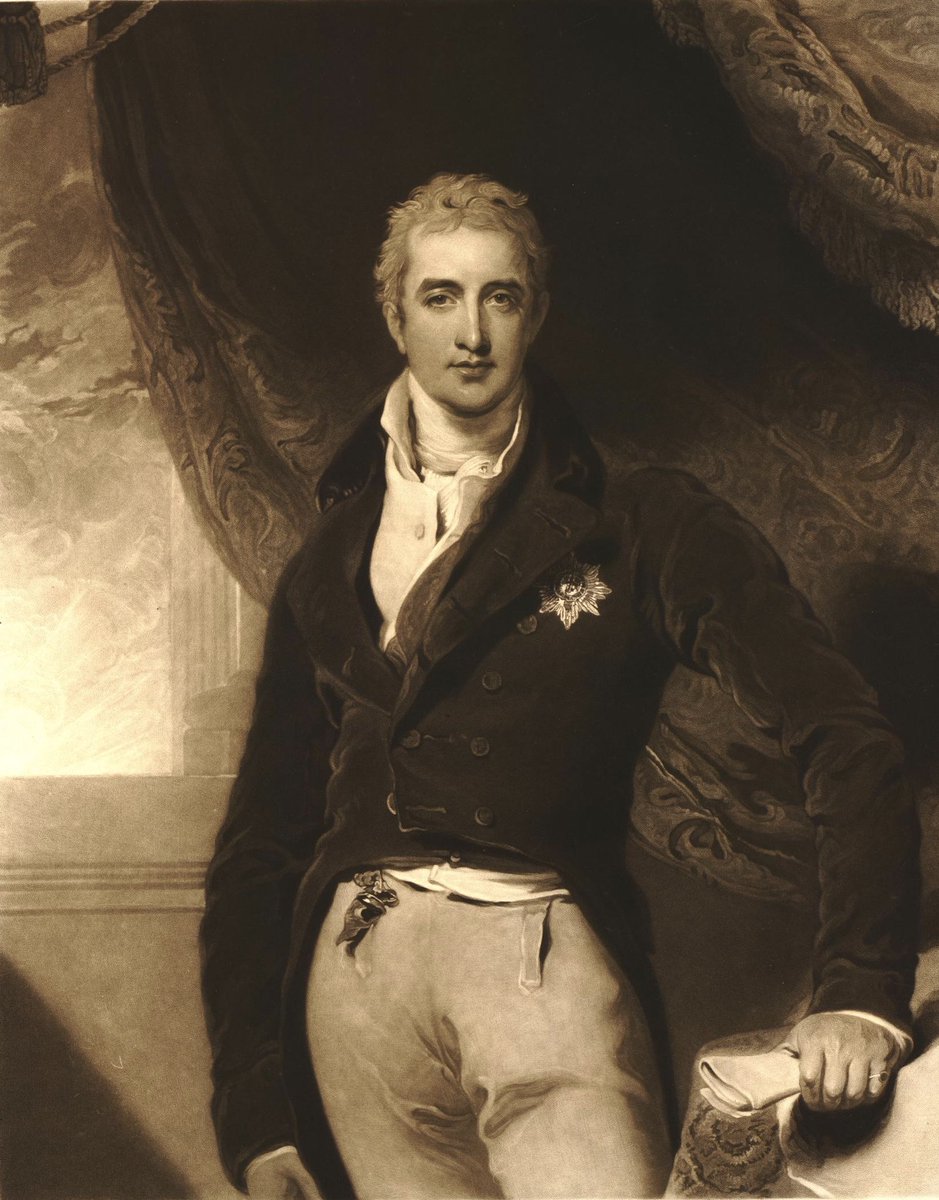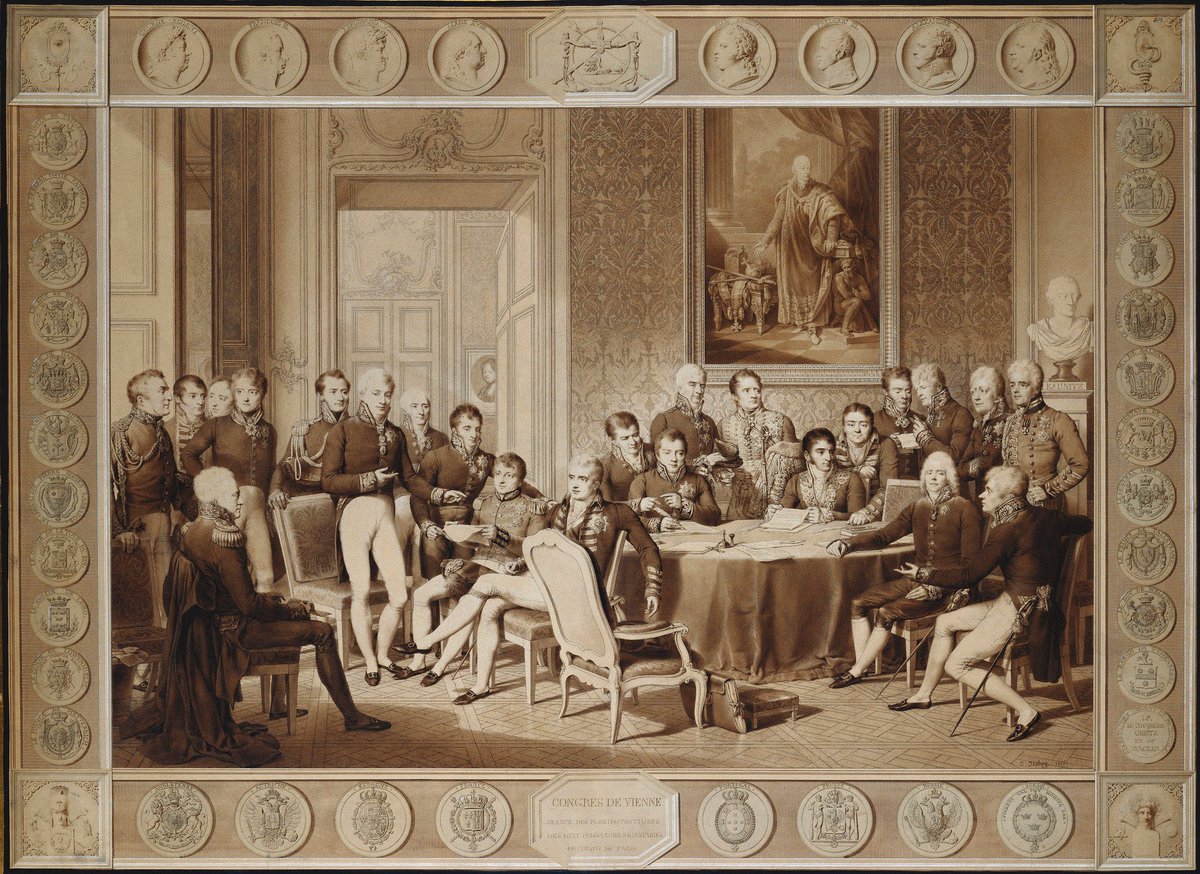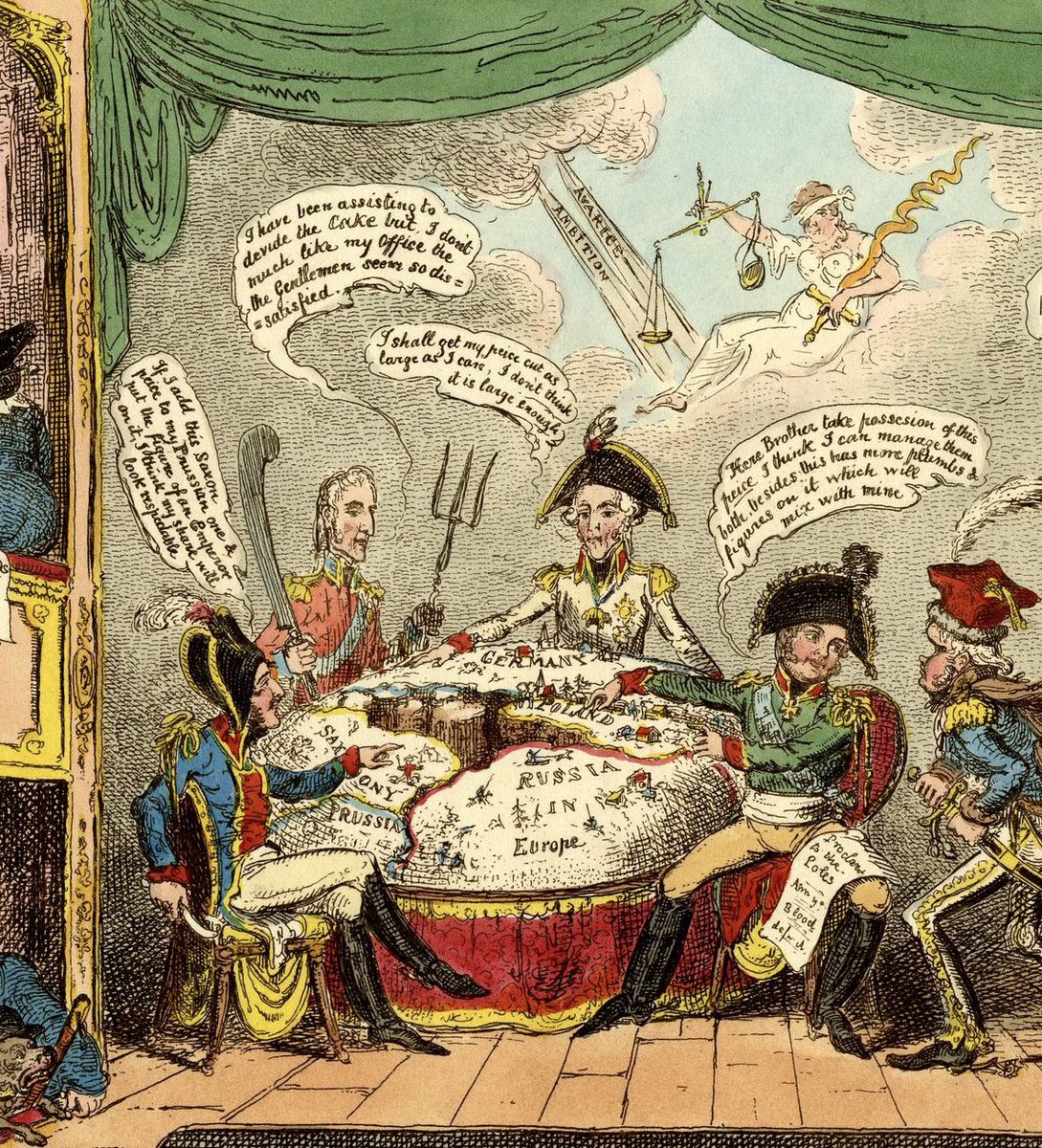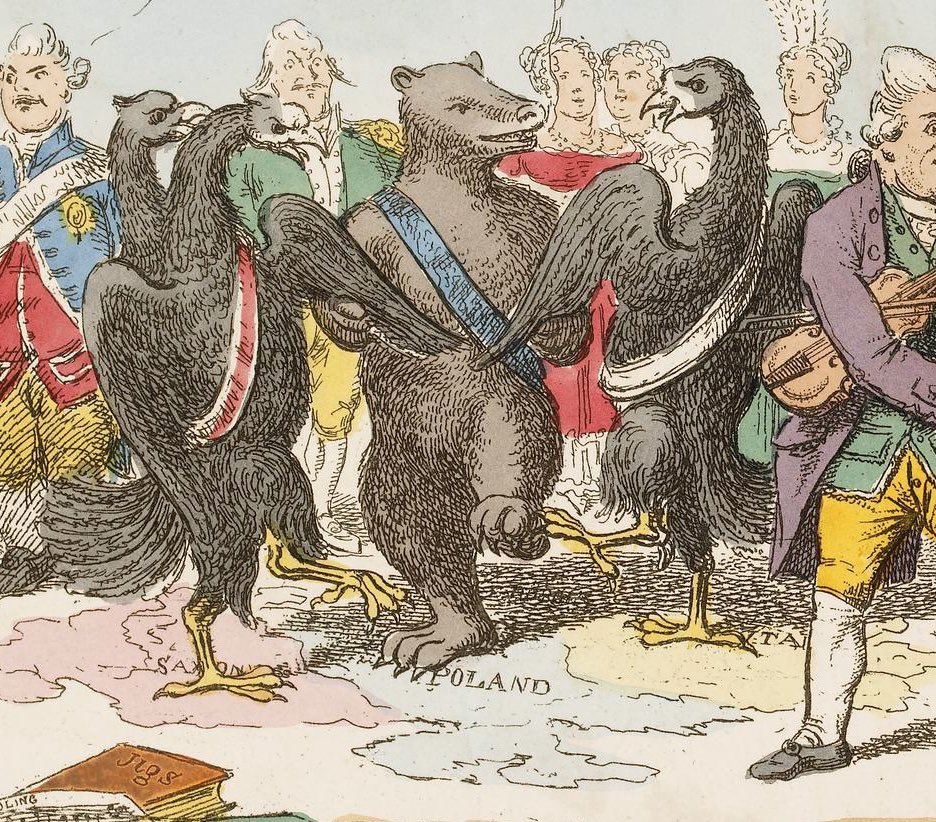On 21 November 1814, #ViscountCastlereagh wrote to PM Liverpool outlining the machinery of the #CongressofVienna, as it had developed to that point.
Castlereagh’s letter is a good starting point for a closer look at the congress machinery and https://abs.twimg.com/emoji/v2/... draggable="false" alt="🇬🇧" title="Flagge des Vereinigten Königreiches" aria-label="Emoji: Flagge des Vereinigten Königreiches">’s representatives.
https://abs.twimg.com/emoji/v2/... draggable="false" alt="🇬🇧" title="Flagge des Vereinigten Königreiches" aria-label="Emoji: Flagge des Vereinigten Königreiches">’s representatives.
1/14
Castlereagh’s letter is a good starting point for a closer look at the congress machinery and
1/14
1) The formal governing group (the Committee of 8):
“The plenipotentiaries of the eight Powers, in number 20, vizt: Austria 2, Russia 3, Great Britain 4, France 4, Prussia 2, Portugal 3, Spain 1, and Sweden 1, meet together occassionally as a directing body.”
2/14
“The plenipotentiaries of the eight Powers, in number 20, vizt: Austria 2, Russia 3, Great Britain 4, France 4, Prussia 2, Portugal 3, Spain 1, and Sweden 1, meet together occassionally as a directing body.”
2/14
However, the informal grouping of GB, France, Austria, Prussia, and Russia (which has been termed the ‘Committee of 5’) was the *real* directing body.
Castlereagh, as head of delegation, was https://abs.twimg.com/emoji/v2/... draggable="false" alt="🇬🇧" title="Flagge des Vereinigten Königreiches" aria-label="Emoji: Flagge des Vereinigten Königreiches">’s representative in both the formal and informal directing bodies. 3/14
https://abs.twimg.com/emoji/v2/... draggable="false" alt="🇬🇧" title="Flagge des Vereinigten Königreiches" aria-label="Emoji: Flagge des Vereinigten Königreiches">’s representative in both the formal and informal directing bodies. 3/14
Castlereagh, as head of delegation, was
2) A working group on Poland, that developed organically:
“The affairs of Poland are left to the three Powers locally interested, with the intervention of Great Britain.”
The three being Austria, Russia, and Prussia. Talleyrand worked bilaterally on Polish issues. 4/14
“The affairs of Poland are left to the three Powers locally interested, with the intervention of Great Britain.”
The three being Austria, Russia, and Prussia. Talleyrand worked bilaterally on Polish issues. 4/14
3) A similar organic working group on German matters:
“At a very early period, a species of commission consisting of the 5 principal German powers, vizt: Austria, Prussia, Bavaria, Hanover, and Wirtemberg, charged themselves with German affairs.” 5/14
“At a very early period, a species of commission consisting of the 5 principal German powers, vizt: Austria, Prussia, Bavaria, Hanover, and Wirtemberg, charged themselves with German affairs.” 5/14
Britain did not *officially* have a representative on the German working group but, given that the British and Hanoverian head of state were one and the same, Hanover’s foreign minister, the Count of Munster [img below], was, to an extent, ‘double-hatted.’ 6/14
4) Formal working group on Swiss matters:
“The affairs of Switzerland have been referred to a commission nominated by the four Allied Powers, consisting of Baron Wessenberg for Austria, Baron Stein for Russia, Lord Stewart for GB [img below] and Baron Humboldt for Prussia.” 7/14
“The affairs of Switzerland have been referred to a commission nominated by the four Allied Powers, consisting of Baron Wessenberg for Austria, Baron Stein for Russia, Lord Stewart for GB [img below] and Baron Humboldt for Prussia.” 7/14
The Swiss committee was charged with ‘framing a report’ on how to achieve the commitments re Switzerland laid out in the Treaty of Paris. The report would the be ‘discussed’ with the Duke d’Alberg, who was the French delegate appointed on Swiss affairs. 8/14
5) A formal working group on Italian matters:
“The affairs of Italy have formed another subdivision, and in order to gain as much time as possible on the important question of Naples, we have been unanimous in first directing our attention to the affairs of Northern Italy.” 9/14
“The affairs of Italy have formed another subdivision, and in order to gain as much time as possible on the important question of Naples, we have been unanimous in first directing our attention to the affairs of Northern Italy.” 9/14
“[...] The protocol will fully explain the course adopted in sending this question also to a preparatory commission consisting of Baron Wessenberg for Austria, Earl of Clancarty for GB [img below], and the Compte de Noailles for France.” 10/14
In December, Castlereagh’s proposal to establish a statistical committee was also adopted. From that proposal:
“There appearing a great Discordance in the Statistical Calculations furnished by the different Cabinets, Lord Castlereagh suggests that the 5 Principal Powers...
11/14
“There appearing a great Discordance in the Statistical Calculations furnished by the different Cabinets, Lord Castlereagh suggests that the 5 Principal Powers...
11/14
...who take the chief interest in the Territorial Arrangements on the side of Germany: viz, Austria, Prussia, GB, France, and Russia [...] should each appoint a Person to verify conjointly these Calculations...”
Clancarty was the https://abs.twimg.com/emoji/v2/... draggable="false" alt="🇬🇧" title="Flagge des Vereinigten Königreiches" aria-label="Emoji: Flagge des Vereinigten Königreiches"> rep on the statistical committee also.
https://abs.twimg.com/emoji/v2/... draggable="false" alt="🇬🇧" title="Flagge des Vereinigten Königreiches" aria-label="Emoji: Flagge des Vereinigten Königreiches"> rep on the statistical committee also.
12/14
Clancarty was the
12/14
There were also some formal committees more administrative in nature, incl a drafting committee ( https://abs.twimg.com/emoji/v2/... draggable="false" alt="🧐" title="Gesicht mit Monokel" aria-label="Emoji: Gesicht mit Monokel">) and a committee on diplomatic precedence (
https://abs.twimg.com/emoji/v2/... draggable="false" alt="🧐" title="Gesicht mit Monokel" aria-label="Emoji: Gesicht mit Monokel">) and a committee on diplomatic precedence ( https://abs.twimg.com/emoji/v2/... draggable="false" alt="😴" title="Schlafendes Gesicht" aria-label="Emoji: Schlafendes Gesicht">)
https://abs.twimg.com/emoji/v2/... draggable="false" alt="😴" title="Schlafendes Gesicht" aria-label="Emoji: Schlafendes Gesicht">)
The issue of the slave trade did get a standing forum, but it was specifically referred to as a less-formal ‘conference.’
13/14
The issue of the slave trade did get a standing forum, but it was specifically referred to as a less-formal ‘conference.’
13/14
Image credits: British Museum, with the exception of the Clancarty portrait, which is from Christies). 14/14

 Read on Twitter
Read on Twitter ’s representatives. 1/14" title="On 21 November 1814, #ViscountCastlereagh wrote to PM Liverpool outlining the machinery of the #CongressofVienna, as it had developed to that point. Castlereagh’s letter is a good starting point for a closer look at the congress machinery and https://abs.twimg.com/emoji/v2/... draggable="false" alt="🇬🇧" title="Flagge des Vereinigten Königreiches" aria-label="Emoji: Flagge des Vereinigten Königreiches">’s representatives. 1/14" class="img-responsive" style="max-width:100%;"/>
’s representatives. 1/14" title="On 21 November 1814, #ViscountCastlereagh wrote to PM Liverpool outlining the machinery of the #CongressofVienna, as it had developed to that point. Castlereagh’s letter is a good starting point for a closer look at the congress machinery and https://abs.twimg.com/emoji/v2/... draggable="false" alt="🇬🇧" title="Flagge des Vereinigten Königreiches" aria-label="Emoji: Flagge des Vereinigten Königreiches">’s representatives. 1/14" class="img-responsive" style="max-width:100%;"/>

 ’s representative in both the formal and informal directing bodies. 3/14" title="However, the informal grouping of GB, France, Austria, Prussia, and Russia (which has been termed the ‘Committee of 5’) was the *real* directing body. Castlereagh, as head of delegation, was https://abs.twimg.com/emoji/v2/... draggable="false" alt="🇬🇧" title="Flagge des Vereinigten Königreiches" aria-label="Emoji: Flagge des Vereinigten Königreiches">’s representative in both the formal and informal directing bodies. 3/14" class="img-responsive" style="max-width:100%;"/>
’s representative in both the formal and informal directing bodies. 3/14" title="However, the informal grouping of GB, France, Austria, Prussia, and Russia (which has been termed the ‘Committee of 5’) was the *real* directing body. Castlereagh, as head of delegation, was https://abs.twimg.com/emoji/v2/... draggable="false" alt="🇬🇧" title="Flagge des Vereinigten Königreiches" aria-label="Emoji: Flagge des Vereinigten Königreiches">’s representative in both the formal and informal directing bodies. 3/14" class="img-responsive" style="max-width:100%;"/>

![Britain did not *officially* have a representative on the German working group but, given that the British and Hanoverian head of state were one and the same, Hanover’s foreign minister, the Count of Munster [img below], was, to an extent, ‘double-hatted.’ 6/14 Britain did not *officially* have a representative on the German working group but, given that the British and Hanoverian head of state were one and the same, Hanover’s foreign minister, the Count of Munster [img below], was, to an extent, ‘double-hatted.’ 6/14](https://pbs.twimg.com/media/EjYe2zhXkAE-qYv.jpg)
![4) Formal working group on Swiss matters:“The affairs of Switzerland have been referred to a commission nominated by the four Allied Powers, consisting of Baron Wessenberg for Austria, Baron Stein for Russia, Lord Stewart for GB [img below] and Baron Humboldt for Prussia.” 7/14 4) Formal working group on Swiss matters:“The affairs of Switzerland have been referred to a commission nominated by the four Allied Powers, consisting of Baron Wessenberg for Austria, Baron Stein for Russia, Lord Stewart for GB [img below] and Baron Humboldt for Prussia.” 7/14](https://pbs.twimg.com/media/EjYe3VVWoAgDoJz.jpg)
![“[...] The protocol will fully explain the course adopted in sending this question also to a preparatory commission consisting of Baron Wessenberg for Austria, Earl of Clancarty for GB [img below], and the Compte de Noailles for France.” 10/14 “[...] The protocol will fully explain the course adopted in sending this question also to a preparatory commission consisting of Baron Wessenberg for Austria, Earl of Clancarty for GB [img below], and the Compte de Noailles for France.” 10/14](https://pbs.twimg.com/media/EjYe4e_WoAE_cQW.jpg)


